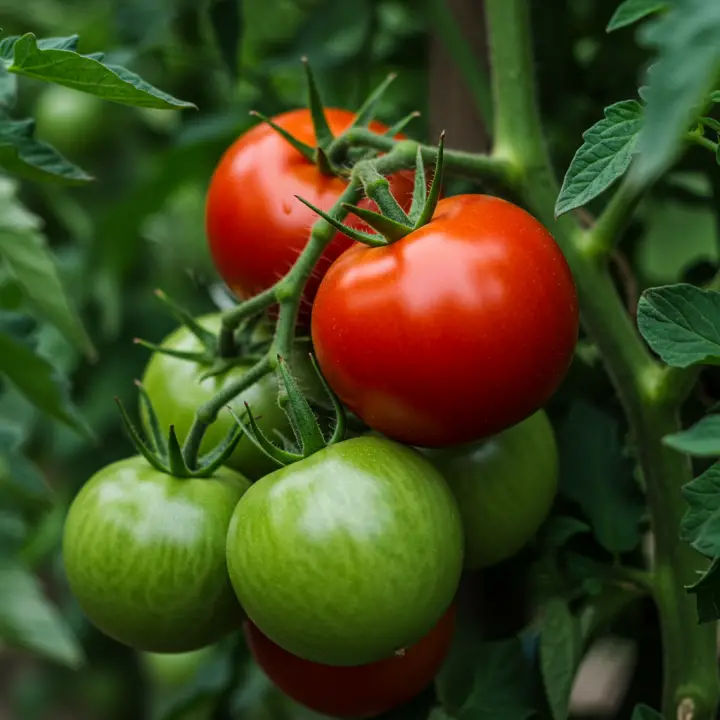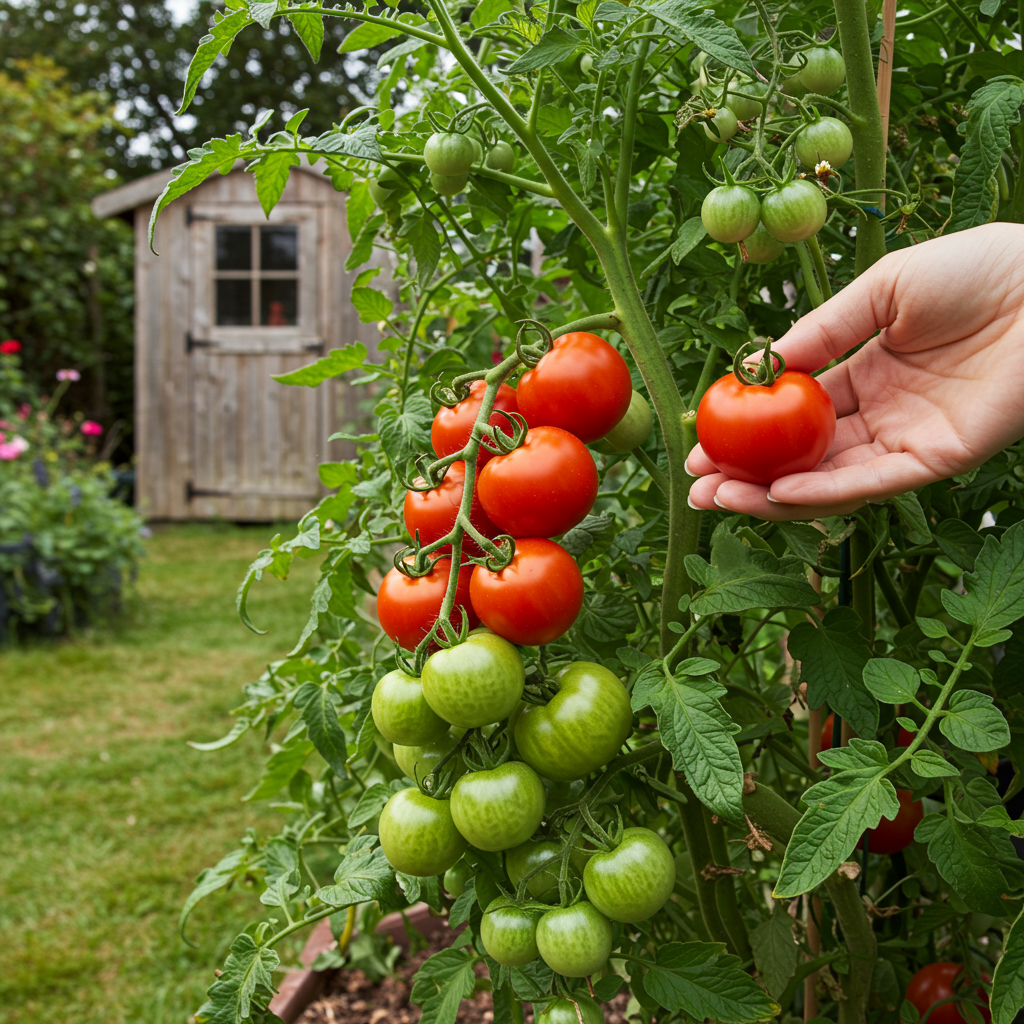To plant tomatoes is to embark on one of the most rewarding journeys a home gardener can take. There is simply nothing that compares to the taste of a sun-warmed, vine-ripened tomato picked fresh from your own backyard. Its flavor is a world away from the bland, mass-produced versions found in most grocery stores. But for many aspiring gardeners, the path from a tiny seed to a bountiful harvest can seem daunting. Fear not! This essential guide will walk you through every step of the process, ensuring you have all the knowledge and confidence you need to grow a spectacular crop of juicy, delicious tomatoes.
Whether you have a sprawling garden plot or a sunny balcony, growing your own tomatoes is an achievable and deeply satisfying experience. We’ll cover everything from choosing the perfect variety for your needs to preparing your soil, mastering the planting technique, and nurturing your plants all season long.
Before You Plant Tomatoes: Choosing the Perfect Variety

The first, and perhaps most crucial, step in your tomato-growing adventure is selecting the right type of tomato to plant. The sheer number of varieties can be overwhelming, but understanding a few key distinctions will make the choice much easier.
Determinate vs. Indeterminate: The Growth Habit
The most fundamental difference between tomato varieties is their growth habit.
Determinate Tomatoes: Often called “bush” tomatoes, these plants grow to a predetermined, compact size (usually 3-4 feet tall). They produce their entire crop of fruit over a relatively short period, typically a few weeks. This makes them an excellent choice for gardeners who want a large harvest all at once for canning, saucing, or preserving. They are also ideal for container gardening due to their manageable size. Popular determinate varieties include Roma, Celebrity, and Bush Goliath.
Indeterminate Tomatoes: These are the vining types that will continue to grow, set fruit, and produce until they are killed by the first frost. They can reach impressive heights of 6-10 feet or more and require sturdy staking, caging, or trellising for support. Their harvest is spread out over the entire season, providing a steady supply of fresh tomatoes for salads, sandwiches, and snacking. Most heirloom varieties and many popular slicing and cherry tomatoes, like Brandywine, Beefsteak, and Sungold, are indeterminate.
Heirloom vs. Hybrid: The Genetics
You’ll also see varieties labeled as “heirloom” or “hybrid.”
Heirloom Tomatoes: These are open-pollinated varieties that have been passed down through generations, prized for their unique flavors, colors, and shapes. Their seeds can be saved and will produce plants true to the parent type. While their flavor is often considered superior, they can sometimes be less disease-resistant and produce lower yields than hybrids.
Hybrid Tomatoes: Hybrids are created by cross-pollinating two different parent varieties to combine the best traits of each, such as high yield, disease resistance, and uniform fruit size. They are often vigorous and reliable growers. The one downside is that seeds saved from hybrid plants will not grow true to type.
Timing is Everything: When to Plant Your Tomatoes
Tomatoes are warm-weather plants that despise the cold. Planting them too early is a recipe for stunted growth or even death. The key to timing is your area’s last average frost date. You can easily find this date online by searching for your zip code or gardening zone.
Starting Seeds Indoors: If you’re growing from seed, you’ll want to start them indoors about 6-8 weeks before your last average frost date. This gives the seedlings plenty of time to develop into strong, healthy plants before it’s safe to move them outside.
Transplanting Outdoors: Whether you started your own seeds or bought seedlings from a nursery, wait to plant them in the garden until 1-2 weeks after the last frost date. It’s crucial that both the air and soil have warmed up. Nighttime temperatures should consistently be above 50°F (10°C).
Seed or Seedling? Two Paths to Tomato Glory
You have two options for getting your plants started: growing from seed or buying young plants (seedlings).
Starting from Seed
Pros: Far greater variety available, much more cost-effective, and immense satisfaction.
Cons: Requires more time, effort, and some basic equipment (lights, containers).
To start from seed, fill small pots or seed trays with a sterile seed-starting mix. Plant seeds about ¼ inch deep, water gently, and cover with a plastic dome to retain humidity. Place them on a heat mat to speed germination. Once the seeds sprout, remove the dome and place them under strong grow lights for 14-16 hours a day.
Buying Seedlings
Pros: Convenient, quick, and perfect for beginners or those short on time.
Cons: Limited variety, more expensive, and a slight risk of introducing diseases to your garden.
When choosing seedlings from a nursery, look for plants with stocky, thick stems and lush, dark green leaves. Avoid plants that are tall and spindly, have yellowing leaves, or are already flowering or setting fruit in their tiny pots. A healthy, compact plant will adapt to your garden much more effectively.
Preparing the Perfect Home for Your Plants
Giving your tomatoes the right environment is essential for a healthy, productive life.
Location, Location, Location
Tomatoes are sun worshippers. Select the sunniest spot in your garden—one that receives at least 6-8 hours of direct, unfiltered sunlight each day. More sun equals more energy, which translates to more fruit.
Soil Preparation for Garden Beds
Tomatoes thrive in rich, well-draining soil with a slightly acidic pH (around 6.2-6.8). Before planting, prepare your garden bed by loosening the soil to a depth of at least one foot. Amend the soil generously by mixing in several inches of well-rotted compost or other organic matter. This improves soil structure, aeration, drainage, and provides a slow-release source of nutrients.
Container Gardening Essentials
If you’re planting in containers, bigger is always better!
Size: Choose a pot that is at least 5 gallons in volume, but 10-15 gallons is even better for indeterminate varieties. A larger pot holds more soil and moisture, preventing the plant from drying out too quickly and becoming stressed.
Drainage: Ensure your container has plenty of drainage holes. Tomatoes hate “wet feet,” and waterlogged soil can lead to root rot.
Soil: Do not use soil from your garden, which will become compacted and waterlogged in a pot. Use a high-quality potting mix designed for containers.
The Main Event: How to Plant Tomatoes for Success
Once your seedlings are ready and the weather is right, it’s time to plant. Before you do, you must “harden them off.” This is the process of gradually acclimating your indoor-grown plants to the harsh outdoor conditions of sun, wind, and temperature fluctuations. Over 7-10 days, bring them outside for a few hours at a time, gradually increasing their exposure until they can stay out all day.
A Step-by-Step Guide to Plant Tomatoes in the Ground
This unique planting method is one of the biggest secrets to growing strong, resilient tomato plants.
1. Dig a Deep Hole: Dig a hole that is significantly deeper than the plant’s current root ball. The goal is to bury a good portion of the main stem.
2. Pinch Off Lower Leaves: Gently pinch off the lowest sets of leaves from the seedling, leaving only the top cluster of healthy leaves.
3. The Secret Technique—Bury the Stem: Place the plant in the hole so that the soil level will be just below the remaining leaves. Tomato stems are covered in tiny hairs called adventitious roots. When buried, these hairs will develop into a robust secondary root system along the entire buried portion of the stem. A bigger root system means better uptake of water and nutrients, leading to a stronger, healthier, and more productive plant.
4. Add Amendments (Optional): For an extra boost, you can add a handful of bone meal or a phosphorus-rich fertilizer to the bottom of the hole to promote root growth. Some gardeners also add a tablespoon of Epsom salt (magnesium sulfate) or crushed eggshells (calcium).
5. Backfill and Water: Gently fill the hole with soil, pressing it down firmly to eliminate air pockets. Water the newly planted tomato thoroughly and deeply to help settle the soil and reduce transplant shock.
6. Spacing: Space determinate varieties about 2 feet apart and indeterminate varieties at least 3 feet apart to ensure good air circulation, which is crucial for disease prevention.

